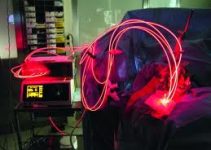Technological advances and surgical techniques have made many different surgeries far less invasive. It used to be that any kind of spinal surgery, whether on the low back or not, was highly invasive.
Nowadays, with the help of tiny cameras called endoscopes, computers, and highly-specialized instruments, back surgery is relatively common and minimally invasive.
However, any kind of surgery for back pain is typically only employed after all other conservative options are exhausted. Read on to find out when endoscopic surgery is needed for lower back pain.

Table of Contents
Different Kinds of Lower Back Pain
According to the American Chiropractic Association, back pain is the leading cause of disability across the world. The reason? Our backs are complex. It’s fair to say that without our backs the way they are, we wouldn’t be nearly as agile as we are. But there’s a price to pay for that agility and range of motion. Backs are easily injured, sprained, tweaked, pulled, irritated, and ruptured. They are under pressure almost all the time and barely get a rest when we’re sleeping.
The bones, ligaments, muscles, and joints that make up the human back are just as— if not more— susceptible to injury as any other part of the body. But back pain doesn’t always arise from direct injury. It can also be caused by obesity, organ problems (like kidney disease), poor posture, and arthritis.
As a result, it can be hard to narrow down the reason for back pain. And even harder to suggest one technique that will help cure, reduce, or prevent it. Fortunately, most back pain is fairly short-lived. Which is one reason why doctors prefer to exhaust all other options before recommending surgery.
Things to Try Before Surgery
Below is a short breakdown of the most common remedies doctors suggest before moving onto any kind of surgery. Of course, every case is different and if a person’s back pain is debilitating or the result of a traumatic injury, surgery may be the best option. More on that later.
Physical Therapy
Physical therapy is one of the most common and effective ways to treat lower back pain. Generally, a physical therapist will use education along with active and passive techniques to remedy the back pain.
- Education
- This means educating the client about proper lifestyle choices.
- Passive Therapy
- Passive therapy includes the use of hot and cold to relieve pain, stimulate the affected area, and reduce swelling. A physical therapist may also use massage techniques and electric therapy to treat lower back pain.
- Active Therapy
- Active therapy is categorized as exercises, stretches, and even weight training in an attempt to strengthen the muscles in or around the affected area.
Chiropractic Care
Chiropractors can do much for low back pain. They focus on aligning the musculoskeletal system to not only stop pain from happening but keep the body in tune and healthy. Chiropractic care is another effective and non-invasive way to treat and prevent lower back pain.
Acupuncture
Many people have found acupuncture to help their low back pain. When you visit a certified acupuncturist they will insert very thin needles into certain places in your body to stimulate pain relief and healing.
Medications and Over the Counter Drugs
For severe back pain, opioids and other painkillers are sometimes prescribed. Usually they are a temporary fix as they only treat the pain and not the underlying cause. For less-severe pain, many people find nonsteroidal anti-inflammatory drugs to work well for their back pain.
Spinal Injections
In certain cases, a doctor may recommend spinal injections to treat low back pain. These injections typically contain steroids and anesthetics.
A Brief Overview of Endoscopic Surgery
Endoscopes of different design and function are used all across medicine. Sometimes they’re used to look inside a body to investigate, as in a colonoscopy. Other times, they’re used to perform surgery, as in some forms of brain tumor surgery like a neuroendoscopy.
The invention of the endoscope has allowed surgeons to perform surgeries through a small slit in the skin that is usually less than an inch long. For neuroendoscopy, the surgery is typically performed through a small hole in the skull.
Before this invention, surgery to remove a tumor or repair back pain was necessarily more invasive and much riskier. While it’s true that endoscopic surgery has shown much promise in treating lower back problems, there’s a reason doctors are hesitant to jump right to surgery.
Even with today’s technology and expert surgeons, there’s a chance that the surgery won’t do much to fix the problem. Plus, for some people, the risk of surgery may be greater than the reward. Particularly for older people or those with existing health problems.
Different Types of Back Surgery
It’s worth noting here that not all back problems that require surgery are necessarily performed with minimally invasive techniques. Endoscopic spinal surgery is only one type of surgery that is typically performed to treat one of the following spinal problems:
- Disk Herniation
- Sciatica
- Spinal stenosis
- Facet arthropathy
Some spinal surgery is much more invasive and risky than endoscopic spinal or low back surgery.
Common Types of Endoscopic Lower Back Surgery
- Endoscopic Foraminotomy
- This surgery is performed to clear away debris blocking or pinching a root nerve in the foramen. This debris can be caused by a herniated disk, bone spurs, or scar tissue.
- Endoscopic Discectomy
- This surgery is performed to alleviate pain on a pinched nerve by a herniated disk. The disk is usually cauterized to prevent further problems after the excess debris has been cleared away.
- Endoscopic Facet Rhizotomy
- Endoscopic Facet Rhizotomy is performed in an effort to relieve pain and other symptoms by deadening the nerves causing the problems.
Benefits and Risks of Endoscopic Surgery
Any kind of surgery has benefits and risks involved. For endoscopic surgery, the risks are low for most healthy people, but they should still be taken into consideration.
- Benefits
- Benefits include Increased motion, pain relief, small scar, little blood loss, recovery in one or two weeks, typically.
- Risks
- Endoscopic surgery is still new, and not many surgeons perform it with regularity. As such, it is not guaranteed to eliminate pain or other symptoms and is only used in a few specific instances.
Common Candidates for Endoscopic Surgery
Determining whether endoscopic surgery is right for any one patient is usually a process of narrowing down. As mentioned above, the ideal candidate typically suffers from disk herniation, sciatica, spinal stenosis, or a few other spinal disorders.
Since it is difficult for specialists to pinpoint the cause of the pain, the best option for treatment usually involves exercise, therapy, or seeing a chiropractor. When all other options are exhausted, a doctor may recommend endoscopic surgery to try to correct the issue.
Conclusion
Endoscopic surgery on the low back and spine is still relatively new and revolutionary. It’s minimally invasive, which is a definite benefit, but the complexities of the spine and back make it difficult to pinpoint the cause of pain and other symptoms troubling the patient. Many people suffer back problems occasionally and almost everyone of a certain age has spinal degeneration. Only a small percentage of people have chronic issues due to back problems.
For those with chronic back pain, it’s definitely worth a look at all non-surgical options before looking for someone to perform endoscopic surgery.
Resources:
https://www.nhs.uk/conditions/endoscopy/
https://www.acatoday.org/Patients/What-is-Chiropractic/Back-Pain-Facts-and-Statistics
https://thejns.org/spine/view/journals/j-neurosurg-spine/98/3/article-p290.xml
About Dr. Wells
Dr. Brent Wells, D.C. founded Better Health Juneau and has been a chiropractor for over 20 years. His practice has treated thousands of patients from different health problems using physical therapy, chiropractic care, and massage therapy designed to help give long-lasting relief.




